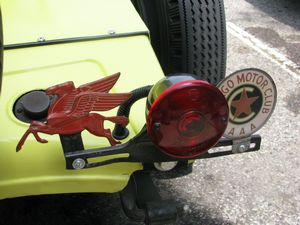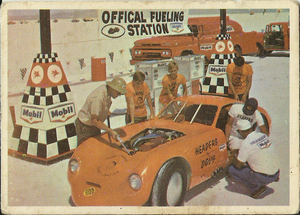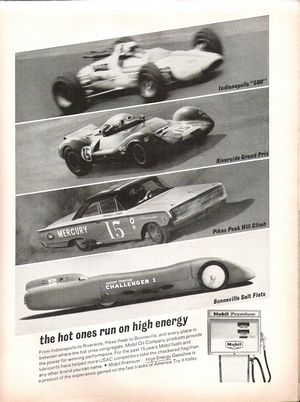















Mobil |
|---|
|
| Topic Navigation |
|---|
|
Official Site: Mobil.com
Wikipedia: Mobil Page Sections History Multimedia Images Article Index |
History
The following section is an excerpt from Wikipedia's Automotive Industries page on 11 April 2017, text available via the Creative Commons Attribution-ShareAlike 3.0 Unported License.
Mobil, previously known as the Socony-Vacuum Oil Company, is a major American oil company which merged with Exxon in 1999 to form a parent company called ExxonMobil. It was previously one of the Seven Sisters which dominated the global petroleum industry from the mid-1940s until the 1970s. Today, Mobil continues as a major brand name within the combined company, as well as still being a gas station sometimes paired with its own store or On the Run. The former Mobil headquarters in Fairfax County, Virginia, were used as ExxonMobil's downstream headquarters until 2015 when ExxonMobil consolidated employees into a new corporate campus in Spring, Texas.
Following the break-up of Standard Oil in 1911, the Standard Oil Company of New York, or Socony, was founded, along with 33 other successor companies. In 1920, the company registered the name "Mobiloil" as a trademark.
Henry Clay Folger was head of the company until 1923, when he was succeeded by Herbert L. Pratt. Beginning February 29, 1928 on NBC, Socony Oil reached radio listeners with a comedy program, Soconyland Sketches, scripted by William Ford Manley and featuring Arthur Allen and Parker Fennelly as rural New Englanders. Socony continued to sponsor the show when it moved to CBS in 1934. In 1935, it became the Socony Sketchbook, with Christopher Morley and the Johnny Green orchestra.
In 1931, Socony merged with Vacuum Oil to form Socony-Vacuum.
In 1933, Socony-Vacuum and Jersey Standard (which had oil production and refineries in Indonesia) merged their interests in the Far East into a 50–50 joint venture. Standard-Vacuum Oil Co., or "Stanvac," operated in 50 countries, including New Zealand, China, and the region of East Africa, before it was dissolved in 1962.
In 1935, Socony Vacuum Oil opened the huge Mammoth Oil Port on Staten Island which had a capacity of handling a quarter of a billion gallons of petroleum products a year and could transship oil from ocean-going tankers and river barges
In 1955, Socony-Vacuum was renamed Socony Mobil Oil Company. In 1963, it changed its trade name from "Mobilgas" to simply "Mobil", introducing a new logo (created by New York graphic design firm Chermayeff & Geismar). To celebrate its 100th anniversary in 1966, "Socony" was dropped from the corporate name.
From 1936 to 1968, Mobil sponsored an economy run each year (except during World War II) in which domestic automobiles of various manufacturers in several price and size classes were driven by light-footed drivers on cross-country runs. The Economy Run originated with the Gilmore Oil Company of California in 1936 (which was purchased by Socony-Vacuum in 1940) and later became the Mobilgas Economy Run, and still later the Mobil Economy Run. The cars driven in the economy run were fueled with Mobil gasoline, and Mobiloil and lubricants were also used. The vehicles in each class that achieved the highest fuel economy numbers were awarded the coveted title as the Mobilgas Economy Run winner.
During American involvement in World War II, April 29, 1942, Socony's unescorted tanker, named Mobiloil, was sunk by a German U-boat (German Type IX submarine U-108 captained by Klaus Schlotz), and all 52 people survived after 86 hours adrift in lifeboats. Socony-Mobil ranked 86th among United States corporations in the value of World War II military production contracts.
Through the years, Mobil was among the largest sellers of gasoline and motor oils in the United States and even held the top spot during the 1940s and much of the 1950s. Various Mobil products during the Socony-Vacuum and Socony-Mobil years included Metro, Mobilgas and Mobilgas Special gasolines; Mobilfuel Diesel, MobilHeat and Mobil-flame heating oil, Mobil Kerosine, Lubrite, Gargoyle, Mobiloil and Mobiloil Special motor oils; Mobilgrease, Mobillubrication, Mobil Upperlube, Mobil Freezone and Permazone antifreezes, Mobilfluid automatic transmission fluid, Mobil Premiere tires, Mobil Stop-Leak, and Mobil Lustrecloth, among many others.
In 1954, Mobil introduced a new and improved Mobilgas Special in response to trends toward new automobiles powered by high-compression engines that demanded higher and higher octane gasolines. The newest formulas of Mobilgas Special were advertised as offering "A Tune-Up in Every Tankful" due to a combination of chemicals known as the "Mobil Power Compound" which was designed to increase power, check pre-ignition ping, correct spark plug misfiring, control stalling and combat gumming up of carburetors. Later Mobil campaigns advertised Mobilgas as the "New Car Gasoline" following extensive testing during the annual Mobilgas Economy Run.
In 1962, the gasoline product lines marketed as Mobilgas and Mobilgas Special were rebranded as Mobil Regular and Mobil Premium in a move to emphasize the shortened brand name "Mobil" in promotional efforts, although Mobiloil continued as a single-word term until the 1970s. After a few years of advertising Mobil gasolines as "Megatane"-rated and as "High Energy" gasolines, Mobil began, in 1966, to promote both its Regular and Premium fuels as "Detergent Gasolines", due to the inclusion of additives designed to clean carburetors and various internal engine parts. During the early 1970s, Mobil ran a TV commercial featuring a character known as "Mr. Dirt" to show the ruinous effects that dirt had on automotive engines for which a tank of Mobil Detergent Gasoline could provide a cure and preventive medicine against damage that could lead to costly repairs.
As automakers were switching en masse from carbureted to fuel-injected engines during the early to mid-1980s, and the detergent additives that existed in most available gasolines proved not to be enough to prevent injection clogging, leading to drivability problems, Mobil received accolades from General Motors and other automakers for increasing the detergency of its Super Unleaded gasoline in 1984 to prevent formation or deposit build-ups of the injectors but also remove existing deposits as well in normal driving. At the end of the 1980s Mobil sold its fuel stations in Norway, Sweden, and Denmark to Norsk Hydro, who converted them into Hydro stations.
William P. Tavoulareas was President of Mobil Corporation until succeeded by Allen E. Murray in 1984.
Mobil moved its headquarters from 150 East 42nd Street, New York City to Fairfax County, Virginia, in 1987. That same year, Mobil sold nearly all of its stations in Western Pennsylvania (including Pittsburgh) to Standard Oil of Ohio (which had just been fully acquired by BP) and terminated franchise contracts with the rest of the stations in the area, withdrawing the Mobil brand from the area for 29 years until a Uni-Mart location in Coraopolis, Pennsylvania started selling Mobil gasoline in 2016.
In 1998, Mobil and Exxon agreed on a merger to create ExxonMobil, which was completed on November 30, 1999. Lou Noto was Chairman of Mobil at the time of the merger, and Walter Arnheim was treasurer.
| 1960's [Mobil Bonneville] Download [Mobil Bonneville] from the Internet Archive - 124MB - 5:28 | |
| 31 August 1965 [0493 Land Speed Tests Footage] Filmed for Mobil Download [0493 Land Speed Tests Footage] from the Internet Archive - 1.0GB - 8:27 | |
| 29 Septmeber 1965 [Mobil Oil unidentified footage] Download [Mobil Bonneville] from the Internet Archive - 205MB - 9:04 | |
| 11 December 2015 13-56909 Efram Dori v. ExxonMobil Oil Corp United States Court of Appeals for the Ninth Circuit Mobil gas station dealers appeal the district court's judgment in favor of Circle K Stores, Inc. and ExxonMobil Corporation in the dealers' diversity action alleging that Exxon's purchase offers to the dealers were not bona fide offers. Download 13-56909 Efram Dori v. ExxonMobil Oil Corp - 318MB - 30:43 |
 |
Mobil License Plate Tag Photo ©2012 Bill Crittenden 2012 Remember Our Heroes Car Show View photo of Mobil License Plate Tag - 3.4MB |
1940's Neptune Mobilgas Gas Pump for $3,700 for $3,7002013 Mecum Chicago Auction Photo ©2013 Bill Crittenden View photo of Mobilgas Gas Pump - 3.4MB | |
| Bowser/Mobilgas No auction information - Mecum Auctions 2013 Mecum Chicago Auction Photo ©2013 Bill Crittenden View photo of Bowser Mobilgas - 3.8MB | |
 |
Subject: Bonneville Streamliner
Source: Hot Rod Spec Sheet Location: Bonneville Salt Flats 
Caption: Bill Burke and Mel Chastain run this streamliner at Bonneville. The front mounted supercharged engine turned 217.64 mph on the salt. Topics: Mobil View image of Hot Rod Spec Sheet "Bonneville Streamliner" Front - 1.9MB View image of Hot Rod Spec Sheet "Bonneville Streamliner" Back - 499KB |
 |
Mobil Premium Motor Trend, August 1965 View photo of 1965 Mobil Premium Advertisement - 3,455KB |
| Date | Article | Details |
|---|---|---|
| 27 August 1925 | PENN CO. ASKS FULL PROBE OF ITS ACTIVITIES “The suit filed against the Penn Oil Company in connection with the alleged misuse of the name 'Mobiloil' is another attempt of the Standard Oil interests to discredit competition in the oil industry,” said Alvin L. Newmayer, attorney for the Penn Oil Company. | News Article (text) Publication: Automotive Daily News Dateline: Washington, D.C.  Topics: Pennzoil, Mobil |
| 27 August 1925 | VACUUM CO. ANSWER “Here is our answer to the Penn Oil Company,” said F. W. Lovejoy, director of sales promotion for the Vacuum Oil Company, to the Automotive Daily News, as he pointed to a letter from the National Better Business Bureau. | News Article (text) Publication: Automotive Daily News Dateline: New York, New York  Topics: Pennzoil, Mobil |
| 18 December 2024 | Man Sentenced to Over Thirteen Years in Federal Prison for Armed Robbery of Indianapolis Gas Station and Shooting of an Employee After shooting the victim, George Tracy told him to “have a good day bro.” | Press Release (text) Publisher: U.S. Attorney's Office, Southern District of Indiana Dateline: Indianapolis, Indiana  Topic: Mobil |
